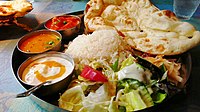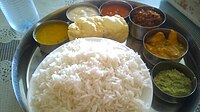Vegetarian cuisine
This article needs additional citations for verification. (October 2014) |
Vegetarian cuisine is based on food that meets vegetarian standards by not including meat and animal tissue products (such as gelatin or animal-derived rennet).[1]
Common vegetarian foods
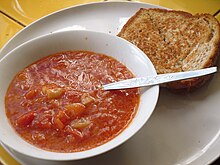
Vegetarian cuisine includes consumption of foods containing vegetable protein, vitamin B12, and other nutrients.[2][3] Food regarded as suitable for all vegetarians (including vegans) typically includes:
- etc.).
- chili sauce and vegetable oils.
- Edible yeasts and moulds) such as Aspergillus oryzae and Fusarium venenatum, although fungi is rarely considered non-vegetarian due to it not being a plant.
- jam and marmalade.
- Legumes: beans (including soybeans and soy products such as miso, edamame, soy milk, soy yogurt, tempeh, tofu and TVP), chickpeas, lentils, peas, peanuts; derived products such as peanut butter.
- Tree nuts and seeds; derived products such as nut butter.
- nettle.
- Meat analogues, which mimic the taste, texture, and appearance of meat and are often used in recipesthat traditionally contained meat.
- Other foods such as seaweed-derived products such as agar, which has the same function as animal-bone-derived gelatin.
- Beverages such as beer, coffee, hot chocolate, lemonade, tea or wine—although some beers and wines may have elements of animal products as fining agents including fish bladders, egg whites, gelatin and skim milk.
Foods not suitable for vegans, but acceptable for some other types of vegetarians:
- Dairy products (butter, cheese (except for cheese containing rennet of animal origin), milk, yogurt (excluding yogurt made with gelatin) etc.) –eaten by lacto-ovo vegetarians and lacto vegetarians.
- Eggs – eaten by lacto-ovo vegetarians and ovo-vegetarians
- Honey
Vegetarians by definition cannot consume meat or animal tissue products, with no other universally adopted change in their diet. However, in practice, compared to non-vegetarians, vegetarians on average have an increased consumption of:
- Fruits
- Vegetables
- Avocados
- Non-fried potatoes
- Whole grains
- Legumes
- Soy foods
- Nuts
- Seeds
In comparison to non-vegetarians, practicing vegetarians on average have a decreased consumption of:
- Dairy products
- Eggs
- Refined grains
- Added fats
- Sweets
- Snacks
- Non-water (often sweetened) beverages
This difference is observed, but is not required to be vegetarian. Nevertheless, it is relevant when considering research into the health effects of adopting a vegetarian diet. A diet consisting only of sugar candies, for example, while technically also vegetarian, would be expected to have a much different outcome for health compared to what is called "a vegetarian diet" culturally and what is most commonly adopted by vegetarians.[4] It is also important to note that overeating occurs because of a misconception of hunger. By changing your perspective on calories verses nutrients, it becomes much easier to adapt to the healthier lifestyle of vegetarianism.[5]
Traditional vegetarian cuisine
These are some of the most common dishes that vegetarians eat without substitution of ingredients. Such dishes include, from breakfasts to dinnertime desserts:

- Traditionally, Brahmin cuisines in most part of India, except Jammu and Kashmir, Odisha and West Bengal, are strictly vegetarian. Onion and garlic is not eaten in a strict sattvic diet.
- Gujarati cuisine and Rajasthani cuisine from the states of Gujarat and Rajasthan are predominantly vegetarian.
- Many bean, pasta, potato, rice, and bulgur/couscous dishes, stews, soups and stir-fries.
- granola bars, etc.
- Fresh fruit and most salads
- Many sandwiches, such as cheese on toast, and cold sandwiches including roasted eggplant, mushrooms, bell peppers, cheeses, avocado and other sandwich ingredients
- Numerous side dishes, such as mashed potatoes, scalloped potatoes, some bread stuffing, seasoned rice, and macaroni and cheese.
- Classical Buddhist cuisine in Asia served at temples and restaurants with a green sign indicating vegetarian food only near temples. Onion and garlic is not eaten in a strict Buddhist diet.
National cuisines
This article should specify the language of its non-English content, using {{lang}}, {{transliteration}} for transliterated languages, and {{IPA}} for phonetic transcriptions, with an appropriate ISO 639 code. Wikipedia's multilingual support templates may also be used. (February 2022) |

- or mixed vegetables.
- Georgian cuisine contains some vegetarian dishes. Lobio, lobiani, ajapsandali, mchadi, pkhali and khinkali with mushroom filling are all examples of Georgian dishes that are vegetarian. Eggplant (called badrijani or badrijnis in Georgian) is used to make vegetarian dishes such as nigvzinai badrijani (fried eggplant stuffed with walnut paste), badrijnis borani (chopped and fried eggplant), badrijnis khizilala (chopped eggplant with pomegranate seeds) and badrijani mtsvanilit (fried eggplant with fresh herbs).
- vegan, though many others use honey or dairy.
- .
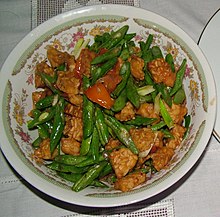
- In . Most of Indonesians do not practice strict vegetarianism and only consume vegetables or vegetarian dishes for their taste, preference, economic and health reasons. Nevertheless, there are small numbers of Indonesian Buddhists who practice vegetarianism for religious reason.
- ), it can be made with vegetable stock as well.
- Korean cuisine has some dishes that are often vegetarian. One example is bibimbap, which is rice with mixed vegetables. Sometimes this dish contains beef or other non-vegetarian ingredients. Another Korean food which is sometimes vegetarian is jeon, in which ingredients (most commonly vegetables and/or seafood) are coated in a flour and egg batter and then pan-fried in oil.
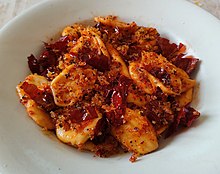
- dishes.
- .
- Italian foods such as most pastas, many pizzas, bruschetta, caponata, crostini, eggplant parmigiana, Polenta and many risottos.
- squash and vegetable-stuffed mushrooms.
- In Germany, Frankfurt quark, spinach, potatoes and herbs provide some traditional vegetarian summer dishes. Traditionally on Fridays, southern Germany broad variety of sweet dishes may be served as a main course, such as Germknödel and Dampfnudel. Potato soup and plum cake are traditional Friday dishes in the Palatinate. Brenntarin Swabia, it is made of roasted flour, usually spelt flour or oat flour.
- Many Greek and spanakopita.
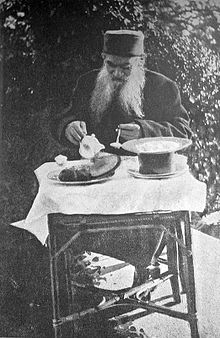
- , fermented and pickled vegetables, etc.
- Many injeeraor Ethiopian vegetable sauces or chillies.
- Mideastern food such as falafel, hummus (mashed chick peas), tahini (ground sesame seeds), minted-yogurts, and couscous.
- kushari and ful medames, are entirely vegetarian, as are usually the assorted vegetable casseroles that characterize the typical Egyptian meal.
- Many dishes in Thai cuisine can be made vegetarian if the main protein element is substituted by a vegetarian alternative such as tofu. This includes dishes such as phat khi mao and, if a vegetarian shrimp paste and fish sauce substitute is used, many Thai curries. Venues serving vegetarian Buddhist cuisine (ahan che; Thai: อาหารเจ) can be found all over Thailand.
- .
- Some Welsh recipes, including Glamorgan sausages, laverbread and Welsh rarebit.
Desserts and sweets
Most
Meat analogs
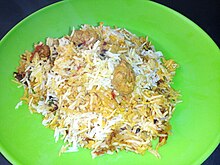


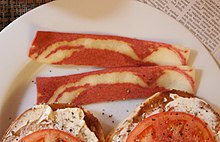
A
Meat alternatives are typically consumed as a source of
Commercial products
Commercial products, marketed especially towards vegetarians and labeled as such, are available in most countries worldwide, in varying amounts and quality. As example, in
Health research
Vegetarian diets are under preliminary research for their possible effects on long-term health. Dietary patterns were evaluated along with their relationship with metabolic risk factors and metabolic syndrome.
See also
- Indian vegetarian cuisine
- Chinese Buddhist cuisine
- Korean vegetarian cuisine
- Veganism
- List of meat substitutes
- List of vegetable dishes
- List of vegetarian restaurants
- List of vegetarian and vegan companies
- South Asian Veggie Table – Vegetarian cooking television show
- Vegetarian Cooking for Everyone
- Vegetarian and vegan symbolism
References
- PMID 16441942.
- ^ "Vegetarian diet: How to get the best nutrition - Mayo Clinic". www.mayoclinic.org. Retrieved 2024-03-03.
- ISSN 0924-2244.
- ^ PMID 25247790.
- PMID 21054899.
- ^ ISBN 3-412-07902-2
- .
- .
- .
- . Retrieved 1 August 2022.
- ^ "All sizzle, no steak: how Singapore became the centre of the plant-based meat industry". The Guardian. 5 November 2022.
- ISBN 978-9971-69-413-5.
- ISBN 978-0-313-32147-4.
- ^ Vegetarian/Vegan Society of Queensland. "Vegetarian/Vegan Supermarket Shopping Guide". Archived from the original on 20 May 2009. Retrieved 7 May 2009.
- PMID 21411506.

